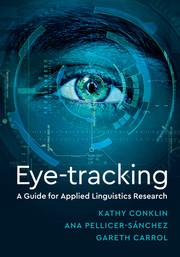Book contents
- Frontmatter
- Contents
- Figures
- Tables
- Preface
- Chapter 1 Introduction to Eye-Tracking
- Chapter 2 Choosing the Equipment
- Chapter 3 Practicalities of Eye-Tracking
- Chapter 4 Researching Reading
- Chapter 5 Researching Listening and Multimodal Input
- Chapter 6 Using Eye-Tracking in Other Contexts
- Chapter 7 Working with the Data
- Chapter 8 Conclusions
- References
- Index
Preface
Published online by Cambridge University Press: 14 September 2019
- Frontmatter
- Contents
- Figures
- Tables
- Preface
- Chapter 1 Introduction to Eye-Tracking
- Chapter 2 Choosing the Equipment
- Chapter 3 Practicalities of Eye-Tracking
- Chapter 4 Researching Reading
- Chapter 5 Researching Listening and Multimodal Input
- Chapter 6 Using Eye-Tracking in Other Contexts
- Chapter 7 Working with the Data
- Chapter 8 Conclusions
- References
- Index
Summary
The eyes provide a window into the mind.
Eye-tracking can in part make this statement a reality. More specifically, by tracking people's eye-movements, we can determine what they are attending to and for how long. By extension, we can make inferences about what they might be thinking about and how much cognitive effort they expend in doing so. We don't need to set an additional task (although we often do); we can simply ask participants to read a text, look at an image or watch a video as they normally would on a computer screen. Importantly, eye-tracking provides a rich moment-to-moment data source. Because of its advantages, it is an essential and well-established research tool in psychology and psycholinguistics, as well as in more applied fields like translation studies. Increasingly, it is being used more widely in a range of applied linguistics domains. While it might seem that eye-tracking is a magic potion that can make our studies more natural, authentic, less contrived, etc., it is simply a tool. Like all tools, it is only as good as the uses we put it to. Even with the best equipment and high-quality materials, with no training we are far more likely to build a rickety shack than a good, sturdy house. Without a clear understanding of the limitations of eye-tracking technology and a good foundation in experimental design and data analysis, eye-tracking technology will likely tell us very little. The goal of this book is to provide readers with a good foundation so that eye-tracking can become a useful and valuable research tool in applied linguistics research.
One aim of this book is to provide researchers with a good understanding of what eye-tracking is and what it can do given the current technical constraints of the equipment. Our focus is on the main eye-tracking systems that are used in language research: SR Research EyeLink, Tobii and SensoMotoric Instruments (SMI) systems. We do not advocate the use of any one system over and above the others. We simply provide information about technical specifications and the dedicated software that the systems use to design experiments and analyse data. This should help readers gain an awareness of the kinds of studies that are appropriate and/or easier to carry out with particular systems.
- Type
- Chapter
- Information
- Eye-TrackingA Guide for Applied Linguistics Research, pp. xiii - xivPublisher: Cambridge University PressPrint publication year: 2018



